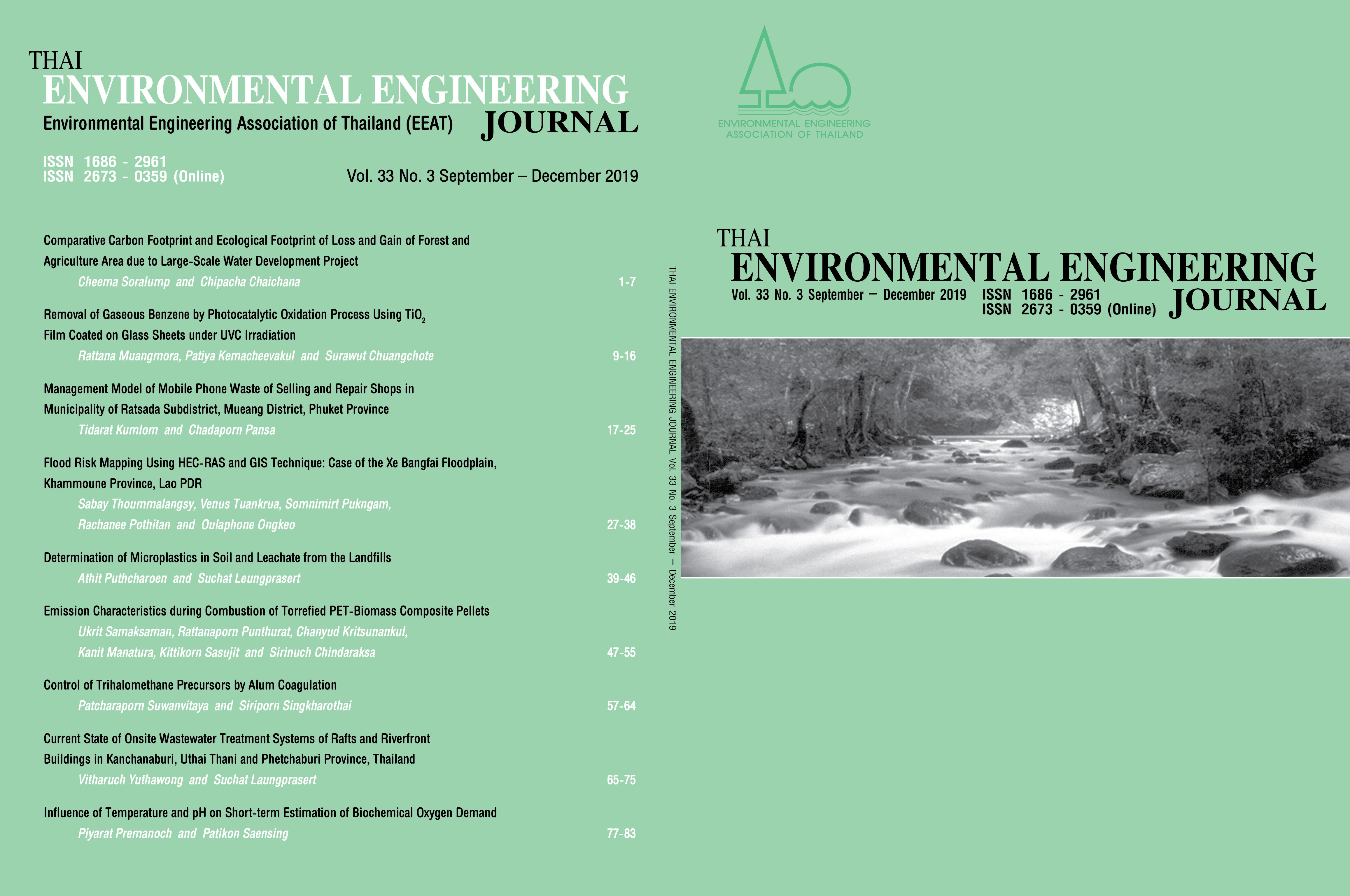Emission Characteristics during Combustion of Torrefied PET-Biomass Composite Pellets
Main Article Content
Abstract
Most of polyethylene terephthalate (PET) bottles, though, has been taken into a recycling system, it still has some problems after preparation and the mechanical process. Waste of PET from the mechanical process is useless and non-recyclable. Pelletizing of such PET waste with biomass such as teak sawdust (TS), eucalyptus sawdust (ES), and corncob (CC) were investigated. Torrefaction of PET-biomass composite pellets was manipulated after pelletizing. Proximate and ultimate analysis as well as the high heating value were deployed to analysis. Moreover, emission characteristics during the combustion of samples of non-torrefied and torrefied pellets; PET/TS, PET/ES, and PET/CC were studied in a lab-scale fixed bed reactor. Emission of flue gas (O2, CO2, CO, SO2, and NOx) and gaseous pollutants (polycyclic aromatic hydrocarbons; PAHs and aromatic hydrocarbons such as benzene, toluene, ethylbenzene, and xylene; BTEX) were determined. The results indicated that flue gases such as CO2, CO and NOx were decreased in the samples of torrefied pellets. SO2 could not be detected due to no sulfur content of the origin materials. The torrefied PET/TS and PET/ES pellets could reduce PAHs compared to the nontorrefied samples indicated as 0.07 and 0.03 g/Nm3, respectively. While emissions of BTEX could not be detected in samples of torrefied PET/TS and PET/ES. Combustion of the torrefied PET/CC pellets caused emissions of PAHs and BTEX with the total concentrations of 6.45 and 0.01 g/Nm3, respectively. Therefore, the torrefaction was a suitable pretreatment method for
PET-biomass composite pellets and altered emission characteristics during the combustion.
Article Details
References
[2] Samaksaman, U., Punthurat, R. and Sasujit K. 2018. Properties of Pellets Produced from Ground Plastic Wastes Mixed with Biomass. Proceedings 14th ENETT Conference on Energy Network of Thailand, Rayong, 769-772.
[3] Lopez, G., Artetxe, M., Amutio, M., Alvarez, J., Bilbao, J. and Olazar, M. 2018 Recent Advances in the Gasification of Waste Plastics. A Critical Overview. Renewable and Sustainable Energy Reviews 82: 576-596.
[4] Andrady, A.L. 2015. Plastics and Environmental Sustainability. John Wiley & Sons Inc., New York.
[5] Conesa, J.A., Rey, L., Egea, S. and Rey, M.D. 2011. Pollutant Formation and Emissions from Cement Kiln Stack Using a Solid Recovered Fuel from Municipal Solid Waste. Environmental Science & Technology 45(13): 5878-5884.
[6] Morton, E.L. 2014. Quality Based Process Engineered Fuel Concept. Proceedings 2014 IEEE-IAS/PCA Cement Industry Technical Conference, Maryland, 1-8. Available online at https://phys.org/news/2017-05-fuel.html
[7] Lasek, J.A., Kopczyński, M., Janusz, M., Iluk, A. and Zuwała, J. 2017. Combustion Properties of Torrefied Biomass obtained from Flue Gas-Enhanced Reactor. Energy, 119: 362-368.
[8] Nhuchhen, D.R. and Afzal, M.T. 2017. HHV Predicting Correlations for Torrefied Biomass Using Proximate and Ultimate Analyses. Bioengineering (Basel) 4(1), 7: 1-15.
[9] Chiou, B.-S., Valenzuela-Medina, D., Wechsler, M., Bilbao-Sainz, C., Klamczynski, A.K., Williams, T.G., Wood, D.F., Glenn, G.M. and Orts, W.J. 2015. Torrefied Biomass-Polypropylene Composites, Journal of Applied Polymer Science, 132: 1-8.
[10] Kanwal S., Munir, S., Chaudhry, N. and Sana, H. 2019 Physicochemical Characterization of Thar Coal and Torrefied Corn Cob. Energy Exploration & Exploitation 37(4): 1286-1305.
[11] Zhang, S., Zhu, S., Zhang, H., Chen, T. and Xiong, Y. 2018. Catalytic Fast Pyrolysis of Rice Husk: Effect of Coupling Leaching with Torrefaction Pretreatment, Journal of Analytical and Applied Pyrolysis, 133: 91-96.


